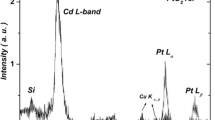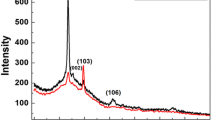Abstract
We investigate diffusivity and conductivity in the context of electronic transport in crystalline cadmium oxide by knowing the electron concentration in CdO as a function of the partial pressure of oxygen in the deposition process of the material in question. From the chemical kinetics of the reaction by which CdO is formed, first we consider an approximate relationship for the electron concentration in terms of the above pressure. In fact, by taking into account this relationship and other issues, we determine the product diffusivity\( \times \)conductivity in crystalline CdO. This product can be considered as a significant figure of merit.
Similar content being viewed by others
Avoid common mistakes on your manuscript.
INTRODUCTION
The chemical kinetics of the reaction by which cadmium oxide is deposited has a special importance with several key aspects which should be investigated successfully in order to get a significant advance in elucidating totally the main physical and chemical mechanisms associated with the formation of CdO. In relation to advanced theoretical studies on the above mentioned key aspects, one should mention [1–5]. On of these key aspects refers to the role of the partial pressure of oxygen in the deposition process of cadmium oxide. This role and other related issues have been examined experimentally in [6–18]. In this respect, consider experimental techniques relative to evaporation. In this context, let us regard activated reactive evaporation [6], reactive thermal evaporation onto glass substrates [7, 8], and vacuum evaporation on a glass substrate at room temperature [9]. Moreover, other significant experimental methods are pulsed laser deposition [10, 11] and some techniques based on sputtering [12–14]. In particular, evaporating elemental cadmium in the presence of oxygen plays a great role [6–9]. This is very important for the purpose of the present paper.
In fact, the aim of the present work is calculating the product diffusivity × conductivity within the context of electronic transport in crystalline CdO formed by evaporating elemental cadmium in the presence of oxygen. To get this end, first we will calculate approximately the electron concentration in CdO as a function of the partial pressure of oxygen in the deposition process of the oxide in question. We will show that this calculation arises from examining the chemical kinetics of the reaction by which CdO is formed. Under these considerations and the Drude model, and employing the fact that the effective electron mass depends on the electron concentration, we will determine the diffusion coefficient and electrical conductivity of crystalline cadmium oxide as functions of the partial pressure of oxygen so we will arrive at an interesting relationship for the product of the above two quantities. This product may be viewed as a notorious figure of merit.
THEORETICAL FORMULATION
We start from the chemical reaction which gives cadmium oxide as follows:
By inspecting reaction (1), it is easy to see that the equilibrium constant for concentrations is equal to the equilibrium constant for pressures, that is:
Cadmium oxide is n-type. The electron concentration of this oxide is proportional to [CdO]. On the other hand, the electron concentration depends on the partial pressure of oxygen [6–9] in the deposition process of CdO (consider evaporating Cd in the presence of oxygen) so, putting \({{P}_{{{{{\text{O}}}_{2}}}}} \equiv P\), we denote the electron concentration as function n(P). Under these conditions, regarding the ideal-gas equation, namely, \(P = RT\left[ {{{{\text{O}}}_{2}}} \right]\) and the evident facts that [Cd2], \({{P}_{{{\text{C}}{{{\text{d}}}_{2}}}}}\) and \({{P}_{{{\text{CdO}}}}}\) are P-independent, then from relation (2) we get:
where γ is a constant (see [4, 5]). This constant can be determined by using the following condition, namely, the maximum value of n(P) is reached at, roughly, the so-called optimum oxygen partial pressure [6] which, by definition, is the value of P such that the optical transmittance of CdO thin films in the visible range is maximum (see, for instance, [6–9]). Therefore, by the above condition and denoting by \({{P}_{0}}\) the optimum partial pressure of oxygen, it follows that \(\gamma \approx {{n}_{{\max }}}\sqrt {{{P}_{0}}} \) so formula (3) becomes:
Relationship (4), which refers to crystalline CdO thin films, agrees qualitatively with experimental data [6]. In this respect, we wish to remark that from formula (4) it follows that the electron concentration decreases as the partial pressure of oxygen increases. This, and other related issues, are consistent with experimental data [6–9]. On the other hand, we want to emphasize that expression (4) corresponds to crystalline cadmium oxide. In fact, for values of P appreciably smaller than \({{P}_{0}}\), the oxide in question is amorphous [6] so that the growth of crystals begins for pressure values clearly larger than the optimum value [6]. It was shown that, at low P, the composition of the CdO films is dominated by excessive cadmium [6].
Now we consider the Drude model by which the electrical conductivity (as a function of P) of CdO (we notice that CdO is only n-type) can be represented as:
where \(\tau \left( P \right)\) denotes electron relaxation time, e is the absolute value of the electron charge, and m* is the electron effective mass which is assumed reasonably, by invoking the plasma-optical effect [19–22] and the so-called Burstein-Moss effect, as dependent of the electron concentration as follows:
where \({{E}_{g}}\left( P \right)\) stands for P-dependent energy band-gap. Note that relation (6) gives the shift experienced by the above gap.
On the other hand, one has:
where l(P) and D(P) are the P-dependent electron mean free path and diffusion coefficient, respectively.
By combining formulae (4) to (7), one obtains:
Relation (8) gives the product diffusivity × conductivity in the context of electronic transport and in terms of the oxygen partial pressure. At this point, we recall the notorious importance of this pressure from both the chemical and technological standpoints. In particular, for CdO thin films prepared by activated reactive evaporation [6], the influence of the aforementioned pressure upon both physical and chemical behaviors of the films in question is certainly very significant.
CONCLUSIONS
Both electronic and ionic diffusivities play an important role in Chemical Physics and Physical Chemistry. In particular, electron diffusivity in thin solid films is an important subject with a number of open questions. In addition, electrical conductivity in thin solid films is another subject with, also, a number of open questions. It is clear that the above questions should be elucidated by using more powerful theoretical techniques for elaborating definitive theories. As a matter of fact, in the present paper, we have developed a theoretical model to determine a relevant figure of merit, namely, the product diffusivity \( \times \) conductivity for electronic transport in CdO thin films. With this model, we have arrived at formula (8), which gives the above figure of merit as a function of the partial pressure of oxygen in the deposition process of the CdO films. Before we have pointed out the significance and relevance of this pressure as, say, a fundamental parameter. Particularly, this can be remarked especially in relation to chemical aspects.
REFERENCES
M. A. Grado-Caffaro and M. Grado-Caffaro, Mod. Phys. Lett. B 9, 1631 (1995).
M. A. Grado-Caffaro and M. Grado-Caffaro, Mod. Phys. Lett. B 18, 1255 (2004).
M. A. Grado-Caffaro and M. Grado-Caffaro, Phys. Lett. A 372, 4858 (2008).
M. A. Grado-Caffaro and M. Grado-Caffaro, Mod. Phys. Lett. B 30, 1650371 (2016).
M. A. Grado-Caffaro and M. Grado-Caffaro, Int. J. Phot. Opt. Technol. 3, 52 (2017).
C. Sravani, K. T. R. Reddy, and P. J. Reddy, Mater. Lett. 15, 356 (1993).
F. C. Eze, Global J. Pure Appl. Sci. 9, 567 (2003).
F. C. Eze, Mater. Chem. Phys. 89, 205 (2005).
A. A. Dakhel and F. Z. Henari, Cryst. Res. Technol. 38, 979 (2011).
M. Yan, M. Lane, C. R. Kannewurf, and R. P. H. Chang, Appl. Phys. Lett. 78, 02342 (2001).
R. A. Ismail, B. G. Rasheed, E. T. Salm, and M. Al-Hadethy, J. Mater. Sci.: Mater. Electron. 18, 1027 (2007).
B. Saha, S. Das, and K. K. Chattopadhyay, Sol. Energy Mater. Sol. Cells 91, 1692 (2007).
T. K. Subramanyam, S. Uthanna, and B. Srinivasulu Naidu, Phys. Scr. 57, 317 (1998).
T. K. Subramanyan, G. Venkata Rao, K. T. R. Reddy, and S. Uthanna, Indian J. Eng. Mater. Sci. 10, 151 (2003).
B. J. Jin, H. S. Woo, S. Im, S. H. Bae, and S. Y. Lee, Appl. Surf. Sci. 169–170, 521 (2001).
B. Li, L. Zeng, and F. Zhang, Phys. Status Solidi A 201, 960 (2004).
A. A. Dakhel, Curr. Appl. Phys. 11, 11 (2011).
T. J. Kuo and M. H. Huang, J. Phys. Chem. B 110, 13717 (2006).
F. Wooten, Optical Properties of Solids (Academic, New York, 1972), p. 52.
R. A. Soref and B. R. Bennett, IEEE J. Quant. Electron. 23, 123 (1987).
H. K. Heinrich, IBM J. Res. Develop. 34, 164 (1990).
M. A. Grado-Caffaro and M. Grado-Caffaro, Act. Pass. Electron. Comp. 15, 63 (1993).
Author information
Authors and Affiliations
Corresponding author
Additional information
The article is published in the original.
Rights and permissions
About this article
Cite this article
Grado-Caffaro, M.A., Grado-Caffaro, M. Evaluating Electron Diffusivity and Conductivity in Crystalline Cadmium Oxide. Russ. J. Phys. Chem. 92, 2723–2725 (2018). https://doi.org/10.1134/S0036024418130101
Received:
Published:
Issue Date:
DOI: https://doi.org/10.1134/S0036024418130101




